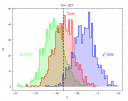Nov 24th, 2007| 09:26 am | Posted by hlee
A piece of thought during my stay in Korea: As not many statisticians are interested in modern astronomy while they look for data driven problems, not many astronomers are learning up to date statistics while they borrow statistics in their data analysis. The frequency is quite low in astronomers citing statistical journals as little as statisticians introducing astronomical data driven problems. I wonder how other fields lowered such barriers decades ago.
No matter what, there are preprints from this week that may help to shrink the chasm. Continue reading ‘[ArXiv] 4th week, Nov. 2007’ »
Nov 18th, 2007| 02:50 am | Posted by hlee
Greetings from Korea. I found that the menu on the right was almost invisible from my mother’s computer. The look seems OS and browser dependent. If you find any problems of viewing the slog, please notify me. Otherwise, please find a paper or two that drag your attention.
Continue reading ‘[ArXiv] 3rd Week, Nov. 2007’ »
Nov 9th, 2007| 12:45 pm | Posted by hlee
There should be at least one paper that drags your attention. Various statistics topics appeared in astro-ph this week.
Continue reading ‘[ArXiv] 2nd week, Nov. 2007’ »
Nov 7th, 2007| 06:52 pm | Posted by vlk
Another one in the CXC/CfA Visualizing Astronomy series: “The Digital Universe: Cosmic Cartography and Data Visualization”, by Brian Abbott of Hayden Planetarium & Department of Astrophysics, next Tuesday, Nov 13, at 2pm in Phillips. Continue reading ‘The Digital Universe’ »
Tags:
2007,
Brian Abbott,
CfA,
CXC,
Digital Universe,
Hayden Planetarium,
Partiview,
talk,
Uniview,
Visualizing Astronomy Category:
Astro,
Imaging,
News |
Comment
Nov 7th, 2007| 11:57 am | Posted by hlee
Today’s arxiv-stat email included papers by Poetscher and Leeb, who have been working on post model selection inference. Sometimes model selection is misled as a part of statistical inference. Simply, model selection can be considered as a step prior to inference. How you know your data are from chi-square distribution, or gamma distribution? (this is a model selection problem with nested models.) Should I estimate the degree of freedom, k from Chi-sq or α and β from gamma to know mean and error? Will the errors of the mean be same from both distributions? Continue reading ‘[ArXiv] Post Model Selection, Nov. 7, 2007’ »
Nov 6th, 2007| 05:47 pm | Posted by aneta
The chi2 bias can affect the results of the X-ray spectral fitting and it
can be demonstrated in a simple way. The described simulations can be done
in Sherpa or XSPEC, the two software packages that allow for simulating the X-ray
spectra using a function called “fakeit”.
Here I assume an absorbed power law model with the sets of 3 parameters
(absorption column, photon index, and normalization) to simulate Chandra X-ray
spectrum given the instrument calibration files (RMF/ARF) and the Poisson noise.
The resulting simulated X-ray spectrum contains the model predicted counts with
the Poisson noise. This spectrum is then fit with the absorbed power law model to get
the best fit parameter values for NH, photon index and normalization.
I simulate 1000 spectra and fit each of them using different statistics: chi2 data variance,
chi2 model variance and Cash/C-statistics.
The next step is to plot the simulated distributions of the parameters and compare them
to the assumed values for the simulations. The figure shows the distribution of the photon
index parameter obtain from the fit of the spectra generated for the assumed simulated value
of 1.267. The chi2 bias is evident in this analysis, while the
CSTAT and Cash statistics based on the likelihood behave well. chi2 model variance
underestimates the simulated value, chi2 data variance overestimates this parameter.

The plot shows the distribution of photon index parameters obtained by
fitting the simulated X-ray spectra with about 60000 counts and using the
three different statistics: chi2 with the model variance, chi2 with
data variance and C-statistics (Cash). The assumed value in the
simulations 1.267 is marked with the solid line.
Nov 2nd, 2007| 05:59 pm | Posted by hlee
To be exact, the title of this posting should contain 5th week, Oct, which seems to be the week of EGRET. In addition to astro-ph papers, although they are not directly related to astrostatistics, I include a few statistics papers which may be profitable for astronomical data analysis. Continue reading ‘[ArXiv] 1st week, Nov. 2007’ »
Tags:
bootstrap,
EGRET,
Fisher information,
Laplace transform,
maximum likelihood,
PCA,
PDF,
Poisson,
Ratio,
Uncertainty,
variance Category:
arXiv |
1 Comment
